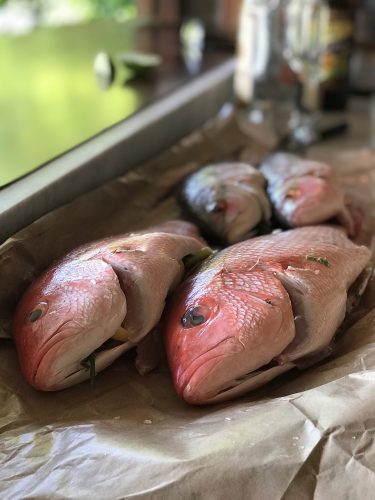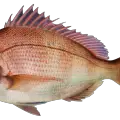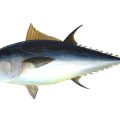The snapper fish family comprises of about 105 species and
of these species only 17 are common and utilized commercially. Snappers are
abundant in tropical waters. They are active fish with elongated bodies, big
mouths, forked or blunt tails and sharp canine teeth. These fish are large, and
most are between 60-90 centimetres in length (2-3 feet). Snappers are
carnivorous, and they feed on other fish and crustaceans. They are used for
food, although the dog snapper (Lutjanus jocu) can cause food poisoning if
consumed since it contains a toxin. Seventeen types of snappers are harvested
in the Caribbean, Gulf of Mexico and South Atlantic waters. The red snapper and
the yellowtail snapper are the most snappers found in the seafood markets.

Red snapper
The red snapper is the most common of the snapper fish
species. It is found in large numbers in the Florida waters. This fish has mild
white meat and a fine texture. It is ideal for any fish recipe and has a
fantastic taste. You can prepare this fish in different ways such as grilling,
broiling, baking or frying. It is a source of first-class white meat. Red
snapper has the same quantities of proteins as shrimp (23grams); additionally,
it is an excellent source of both iron and calcium. The red snapper is among
the most sought after deep-sea delicacies; despite their attractive appearance,
the red snapper has a tantalizing taste. Red snapper is fished commercially as
well as recreationally. They are found in sea waters of about 30 -200 feet. Occasionally,
this fish can be caught at a depth of 300 feet in the sea waters. They prefer
inhabiting areas close to the sea floor, and you’ll find them on ridges, rocky
ledges, artificial reefs, shipwrecks and offshore. You can cook red snappers
via any methods used for preparing fish. In the seafood market, you can identify
red snapper through its shiny surface, with tight gills and scales that are
pink or deep red. Additionally, you can check for a shiny clean belly without
any cuts and a mild aroma characteristic of the ocean. The steaks, loins and
fillets have a translucent appearance, and the flesh is firm. The flesh should
have no discoloration. If properly packed, the fish will not present in any
unnatural bent.
Yellowtail snapper (Ocyurus chrysurus)
As the name describes it, the yellow snapper derives its
name from its yellowtail. It has a noticeable lateral yellow line that runs
from the snout to the tail. Of all the fish harvested from the Florida waters, many
culinary experts regard the yellow snappers as the tastiest. This nutritious,
delicious fish is comparable to the red snappers. One can be prepared in the
same ways the red snappers in a variety of cooking methods. The yellow snapper
has yellow and pink longitudinal stripes; the tail is forked and bright yellow
in color. Distinct yellow stripes run from the snout to the tail. Additionally,
it has yellow and bluish olive spots on its top. The yellow tails snapper lacks
lateral spots. Other popular snapper species in the seafood market include:
Mutton snapper (Lutjanus analis)
This snapper fish has an olive-green coloration on its top.
The lower fins are red in color while the anal fin is pointed. Below the eye,
the mutton snapper has a contoured bluefin. Below the dorsal fin, the fish has
a little lateral dark spot. Additionally, it has V-shaped tooth I the upper
roof of its mouth.
School master snapper (Lutjanus apodus)
This snapper species is olive-grayish in color. The body has
yellowish vertical strips and an extended snout. School master snapper has a
reddish coloration close to its head. Below the eyes, a bluish interrupted
stripe. This fish lacks a lateral black spot.
Cubera Snapper (Lutjanus cyanopterus)
Its body is dark brown with an additional red hue. In both
the upper and lower jaw, it has protruding canine teeth. The fins have a
slightly bluish tinge. Its teeth are broadly arranged in a triangular fashion
on the roof of the mouth.
Twinspot snapper (Lutjanus bohar)
The twinspot snapper appears like its frowning and has a bluish-green
top and yellow colored eye. The underbelly is grayish –white. The fish has
dark-colored fins and a triangular snout. The body has white lateral linear
spots.
Vermillion Snapper (Rhomoplits aurorubens)
The vermillion snapper has a reddish body and a whitish
belly. It lacks canine teeth and a lateral darks spot. On its top rests
irregular, short diagonal bluish lines.
Dog snapper (Lutjanus jocu)
The body is brownish with bronze like accents. Its fins have
a yellowish-orange tinge. Below the eye, it has a bluish interrupted line and a
pale triangle. The dog snapper lack as a dark spot on the dorsal fin and
lateral side. It has sharp canine teeth of which one pair appears enlarged and
protruding.
Emperor red snapper (Lutjanus sebae)
It has a triangular snout and spiny fins. The eyes are dark
red. The emperor snapper has a faintly forked tail fin. The body is covered
with alternating white and dark red stripes. The fish lacks both dorsal and
lateral dark spot.
Mangrove snapper (Lutjanus griseus)
The mangrove snapper is also known as the gray snapper. It
has a dark-brown, grayish color on its body. It has vertical orange and reddish
spots. Besides, it has two canine teeth on its upper jaw. The fins possess a
reddish tinge. The mangrove snapper lacks dorsal and lateral dark spot.
Silk snapper (Lutjanus vivanus)
Its body comprise of shades of orange, red and pink. Silk
snapper has yellow pectoral fins and a sharp anal fin. The brink of the tail
fin is black. The fish lack both lateral and dorsal dark spot. The sides are
silver with yellowish lines.
Queen snapper (Etelis oculatus)
The fish has an elongated body with a bright reddish color
on its top. The underbelly and the sides are silvery. It has a notch on the
dorsal fin. Queen snapper has huge and protruding eyes. It has a deep fork on
its tail fin. A finally it lacks both lateral and dorsal dark spot.
Bluestripe snapper (Lutjanus kasmira)
The body has a bright yellow color, with four or five
lateral longitudinal stripes. The lower body and the underbody are white in
color. The lower lateral portion of the body has pale gray lines. The fish has
yellow fins. It lacks both lateral and dorsal dark spot.
Lane snapper (Lutjanus synagris)
The body is pinkish-red with alternating longitudinal-dashed
yellow and pink lines. The brink of the tail fin is blackish. The lane snapper
has a huge, faded lateral black spot.
Blackfin snapper (Lutjanus buccanella)
The body is red in color with yellow fins. Additionally, it
has a dark crescent shape at the bottom of the pectoral fins (a blackfin). It
has rounded fins and lacks both dorsal and lateral dark spot.
Papuan black snapper (Lutjanus goldiei)
Its body is greenish in color. It has black fins and a broad
snout. Besides, it has prominent scales and patches and dark spots on the body.
Mahogany snapper (Lutjanus mahogoni)
Mahogany snapper has a greenish-gray body and a red tinge.
The tail fin and eyes are bright red. It has protruding pines along the fins.
Additionally, it has a lateral, dispersed dark spot.
It is possible to distinguish the snapper species based on
the unique characteristic of each. The major characteristics are crucial in the
identification of snapper species.












Pingback: Best 4 Snapper Reels Review | Reel Fishing Guru
Pingback: Snapper fishing rod reviews | Reel Fishing Guru
Pingback: How Big Can a Grouper Get? | Reel Fishing Guru